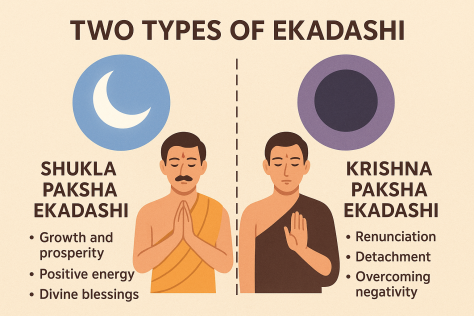
Ekadashi is an auspicious day in the Hindu calendar observed twice a month—on the eleventh day of both the waxing moon (Shukla Paksha) and the waning moon (Krishna Paksha). Devotees consider this day spiritually significant, as fasting and prayers performed on Ekadashi are believed to purify the mind and body while bringing one closer to divinity.
While there are many Ekadashis throughout the year, the two broad types are:
1. Shukla Paksha Ekadashi (Bright Fortnight)
This Ekadashi occurs during the waxing phase of the moon, when the moon is growing brighter. It symbolizes growth, prosperity, and spiritual enlightenment.
-
Spiritual Meaning: Shukla Paksha Ekadashi is associated with positivity, divine blessings, and progress in life.
-
Practices: Devotees fast from grains and beans, spend time in meditation, and recite sacred texts like the Bhagavad Gita or Vishnu Sahasranama.
-
Belief: Observing Shukla Paksha Ekadashi is said to grant mental clarity, spiritual strength, and the blessings of Lord Vishnu.
Example: Vaikunta Ekadashi (occurring in Shukla Paksha of Margashirsha month) is one of the most important Ekadashis, believed to open the gates of salvation.
2. Krishna Paksha Ekadashi (Dark Fortnight)
This Ekadashi falls during the waning phase of the moon, when the moon is gradually fading. It symbolizes self-discipline, letting go, and inner purification.
-
Spiritual Meaning: Krishna Paksha Ekadashi focuses on renunciation, detachment, and overcoming negative influences.
-
Practices: Devotees practice strict fasting, engage in prayer, and chant the names of Lord Vishnu to cleanse past karmas.
-
Belief: Observing Krishna Paksha Ekadashi helps remove sins, reduce mental burdens, and strengthen devotion.
Example: Nirjala Ekadashi (occurring in Krishna Paksha of Jyeshtha month) is the strictest Ekadashi fast, where devotees refrain even from water.
Why Are There Two Types of Ekadashi?
The Hindu calendar is based on the lunar cycle, and each month is divided into two phases:
-
Shukla Paksha (waxing) – symbolizing growth and expansion.
-
Krishna Paksha (waning) – symbolizing introspection and release.
By observing both types of Ekadashi, devotees balance their spiritual journey between growth and discipline, ensuring harmony of mind, body, and soul.
Final Thoughts
Ekadashi is more than a fasting ritual—it is a spiritual tool that helps align individuals with higher consciousness. Shukla Paksha Ekadashi inspires growth and positivity, while Krishna Paksha Ekadashi teaches discipline and renunciation. Together, they create a complete spiritual practice, guiding devotees toward inner peace and divine connection.

Comments (0)
To comment, please Login